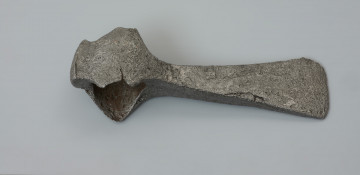
Battle axe (pickax)
701 — 1000
National Museum in Szczecin
Part of the collection: Middle Ages
Early medieval axe heads dredged up from the bed of the Western Oder in June 1939 at the level of the village of Moczyły in the current Police district. Axes consisted of two main elements: metal blades, usually iron, and wooden handles on which they were set. They could reach a size of 60 cm to over a meter. In the construction of an axe, one distinguishes between the beard, the moustache and the hood. The beard is the part of the blade that extends downwards considerably, which increases the surface area and makes it possible to hook an opponent's shield during a fight. The whiskers is located at the point where the blade is set on the axe, near the axe. Its function was to fix the metal part of the axe more tightly on the wooden handle. The hood, or impact face, is located on the opposite side concerning the blade. It can be pulled up and down or only down. The cast irons excavated from the Oder River is massive, with the blade slightly asymmetrically lowered to the axe. The hilt is finished with a short, strongly distinguished, bar-shaped thickening, the so-called hammer. The neck passes into a narrow, asymmetrical and arched blade ending in a distinctive, obliquely cut narrow beard. It can be dated to the 2nd half of the 8th - 9th centuries based on analogous specimens from well-dated archaeological sites.
Sławomir Słowiński
Author / creator
Dimensions
cały obiekt: height: 9.9 cm, width: 5 cm
Object type
axe, hatchet, weapon
Material
iron
Origin / acquisition method
legal transfer
Creation time / dating
Creation / finding place
Owner
Muzeum Narodowe w Szczecinie
Identification number
Location / status